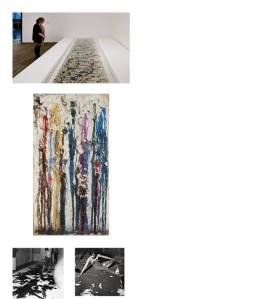This exhibition has been slated by the critics and it is true there are some pretty confusing elements, but for me the opportunity to see the films of Kazuo Shiraga and Niki de Saint Phalle make up for that.
The choice of David Hockney is out of place and seems to illustrate the lack of nerve by the curators to embrace performative painting full-on.
There is however a logical progression from Jackson Pollock dripping paint, to staged performances of Yves Klein’s Anthropometries or the Viennese Actionists where the vestiges of the performances remain as painted marks. Room 4 features some great photos of Stuart Brisley, but there is little space given to Ana Mendieta and none at all to Carolee Schneemann, which is a shame. The exhibition documents the changing importance of the painting to a time when the performance holds the agency without the need for a stand-alone painting.
By Room 5 we have moved onto the performer and no trace of an external painting. The body is the painting. In my mind the exhibition could have ended here and remained a historical look at painting into performance.
The exhibition’s by-line ‘Painting After Performance’ led me to expect that we might see a tighter link between contemporary painting and performance- work that concerns itself with the complicated line between performance and painting. Instead the contemporary artists shown are only tacitly dealing with this.
My disappointment is because I am struggling to negotiate this line myself- a sometimes vain attempt to produce paintings that speak of the process that went into creating them.
From Room 6 the exhibition loses its focus. I was hoping the curators would clarify how the trajectory from painting to performance is being explored in contemporary painting today, but instead we get an anything goes mish-mash of installation and sculpture. In conversation with assistant curator, Fiontán Moran, I gathered that in his view the painter as performer is still credible, but not an area which they wanted to explore in the show. There are many painters working now in a performative way, but they do not feature in the contemporary section. It would have brought vitality to the exhibition had they risked showing contemporary painters. The combination of paint and action is still vital. Reading Dan Coombs’ review of the exhibition in Abstract Critical, he laments the paucity of the paintings shown post Pollock, such as Shiraga’s paintings made with his feet. He sees these records lacking the beauty and formal qualities of Pollock’s Summertime. Echoing this there is a word of warning at the start of the exhibition, a quote from Allan Kaprow that suggests that many paintings made subsequently to Pollock’s are only ‘near-paintings’.
This tension between the desire to utilise raw feelings and experience in the painting process with the need for the painting to work in its’ own right makes for contentious debate. I place my own work within this struggle to produce valid paintings which are generated through performative elements. In ‘The Bigger Splash’ the curators have avoided such debate, but in avoiding contemporary performative painters in the second half of the exhibition I believe the show loses its potential to invigorate and stimulate its audience.


Nice